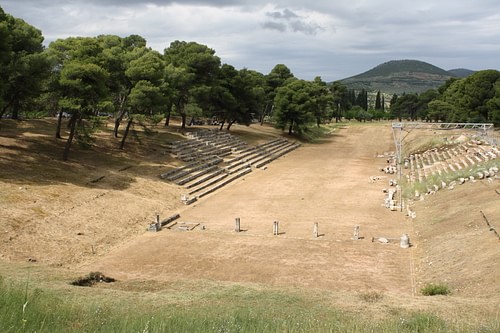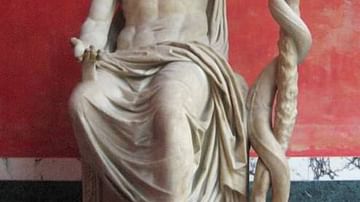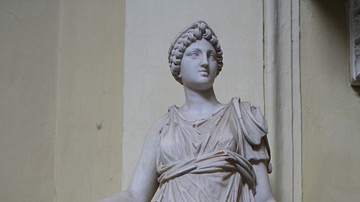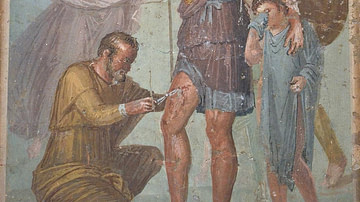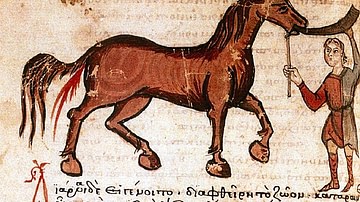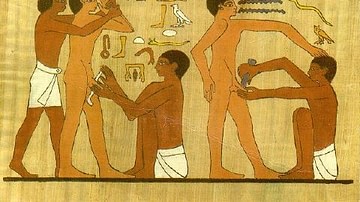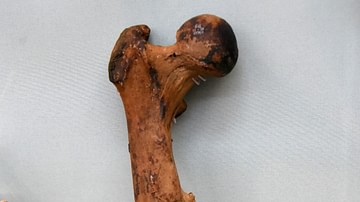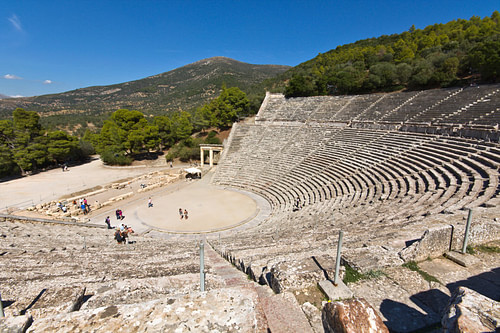
Epidaurus was an ancient religious site and settlement located on the fertile Argolid plain of the east Peloponnese in Greece. Blessed with a mild climate and natural springs, the sanctuary of Asclepius at Epidaurus was an important sacred centre in both ancient Greek and Roman times. The site, which includes the massive theatre of Epidaurus, is a UNESCO World Heritage Site.
Epidaurus was named after the hero Epidauros, son of Apollo. Inhabited since Neolithic times, the first significant settlement was in the Mycenaean period. Fortifications, a theatre and tholos tombs have been excavated dating as early as the 15th century BCE, although it was in the 12th century BCE that Epidaurus Limera, with its harbour linking it to the Aegean trade network, particularly flourished.
Earlier regional worship of the deity Maleatas evolved into the later worship of Apollo, who was given similar attributes. However, it was Asclepius (also spelt Asklepios), whom the Epidaurians believed was born on the nearby Mt. Titthion, who took precedence from the 5th century BCE until Roman times in the 4th century CE. Credited with possessing great healing powers (learnt from his father Apollo) and also those of prophecy, the god - as manifested in the sanctuary or Asklepieion - was visited from all over Greece by those seeking alleviation of their ailments by either divine intervention or medicines administered by the resident priests. The sanctuary used the wealth gained from dedications from the worshipers to build an impressive complex of buildings and to sponsor major art projects to beautify the centre. Indeed, many of the offerings given were works of art such as statues, pottery vessels, tripods and even buildings.
At the height of the site's importance in the 4th century BCE (370-250 BCE), major buildings included two monumental entrances (Propylaia); a large temple (380-375 BCE) with the typical 6 x 11 column Doric layout, containing a larger than life-size Chryselephantine statue of a seated Asclepius (by Thrasymedes) and with pediments displaying in statuary the Amazonomachy and the Siege of Troy; temples dedicated to Aphrodite (320 BCE), Artemis and Themis; a sacred fountain; the Thymele (360-330 BCE) - a round marble building originally with 26 outer Doric columns, a 14 Corinthian columned cella and a mysterious underground labyrinth, perhaps containing snakes which were associated with Asclepius; the columned Abato (or Enkoimeterion) in which patients waited overnight for divine intervention and remedy; other temples, hot and cold bath houses, stoas, stadium, palaistra and large gymnasia; and a 6000 seat theatre (340-330 BCE). These latter sporting and artistic buildings were used in the Asklepieia festival, founded in the 5th century BCE and held every four years to celebrate theatre, sport and music.
The theatre of Epidaurus, with 2nd century CE additions resulting in 55 tiers of seats and a capacity of perhaps 12,300 spectators, would become one of the largest ancient theatres ever built. The theatre has exemplary acoustics which allowed performers to be heard even at the very top rows of seats. Other Roman additions to the site in the 2nd century CE under the auspices of the Roman senator Antonius, included a temple of Hygieia, a large bath building and a small odeum.
The site was destroyed in 395 CE by the Goths and the Emperor Theodosius II definitively closed the site along with all other pagan sanctuaries in 426 CE. In the 6th century CE the site was definitively abandoned following earthquakes in 522 and 551 CE. Excavations at the ancient site were first begun in 1881 CE under the auspices of the Greek Archaeological Society. Research continues to the present day, adding ever-more knowledge of the many ancient monuments that made up this impressive site. Artefacts can be seen at the Archaeological Museum of Epidaurus at the site. Today, the magnificent theatre of Epidaurus is still in active use for theatrical performances in an annual traditional Greek theatre festival.
